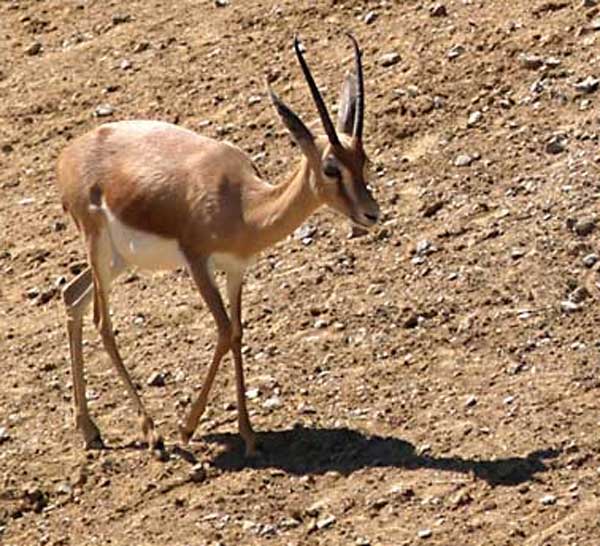Gazella dorcas, Photo: Frithjof Spangenberg Cladus: Eukaryota Name Gazella dorcas (Linneaus, 1758) References * Gazella dorcas on Mammal Species of the World. Vernacular names
The Dorcas Gazelle (Gazella dorcas), also known as the Ariel Gazelle, is a small and common gazelle. The Dorcas Gazelle stands approximately 55-65 cm (1.8-2.1 ft). Dorcas gazelle have a head and body length of 90-110 cm (3-3.6 ft) and a weight of 15-20 kg (33-44 lb). The numerous subspecies of the Dorcas Gazelle survive on vegetation in grassland, steppe, wadis, mountain desert and in semi-desert climates of Africa and Arabia. About 35,000 - 40,000 exist in the wild. The extinct Saudi Gazelle from the Arabian Peninsula has been previously considered as a subspecies of the Dorcas Gazelle.
Gazella dorcas beccari Eritrean Dorcas Gazelle
The Dorcas gazelle is similar in appearance to, yet smaller than, the closely related Mountain Gazelle (Gazella gazella). Dorcas have longer ears and more strongly curved horns, which bow outwards then turn inwards and forwards at the tips. Individuals belonging to the Saharan subspecies (G. d. osiris) have a very pale fawn colored coat. The white underside is bordered with a brown stripe, above which there is a sandy stripe. The forehead and face are darker than the body. Subspecies from north of the Sahara tend to be more ochre in color, and have dark flanks and facial stripes. Populations in Israel and around the Red Sea are darker and more reddish. In the last century the populations of Dorcas gazelle were partially destroyed in all the countries that was its subsistence. Currently, there are large populations of Dorcas gazelles in the Negev and the Arava. There are other large populations in Sudan, Iraq and the southern part of the eastern desert of Egypt. In Israel there are only between 1000-1500 gazelles. Behaviour
Breeding When conditions are harsh, Dorcas Gazelles live in pairs, but when conditions are more favorable they join together in family herds with one adult male, several females and young. During the breeding season, adult males tend to be territorial, and mark their range with dung middens. In most parts of their range, mating takes place from September to November. Gestation takes six months; a single fawn is typical, although twins have been reported in Algeria. The newborn is well developed at birth, with fur and open eyes. Within the first hour, the fawn attempts to stand, and it will suckle on this first day of life. In the first two weeks, the young gazelle lies curled up in a scrape on the ground or beneath bushes while the mother grazes close by. The young then starts to follow its mother around and begins to take solid food. After around three months, the fawn stops suckling and is fully weaned. Some Dorcas are also known for their dangerous behaviors when surrounded. There have been many reports of deaths involving the Dorcas Gazelles. Source: Wikipedia, Wikispecies: All text is available under the terms of the GNU Free Documentation License |
|


